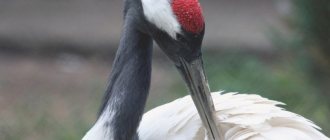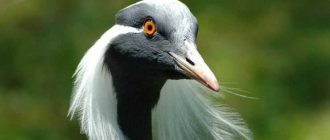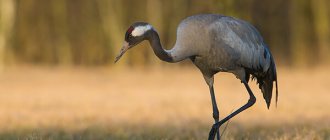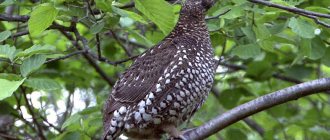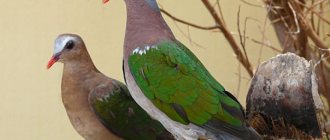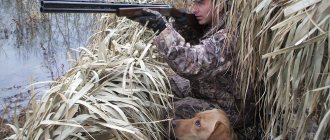- Wild animals
- >>
- Birds
The Siberian Crane is a very rare species of crane, a tall and slender white bird that nests in only two places in northern Russia, and goes to China or India for the winter. During the 20th century, their population fell greatly, and now the Siberian Cranes need human help to survive - in Russia and other countries there are programs for their conservation and breeding.
Origin of the species and description
Photo: Sterkh
Birds evolved from archosaurs - this happened about 160 million years ago. Few intermediate forms have been preserved, allowing us to trace the early evolution, but the most ancient birds retained characteristics that united them with lizards. Over the course of millions of years, they developed and their species diversity increased.
Of the modern birds, the craneformes order, which includes the Siberian Crane, is one of the earliest. Researchers believe it is highly likely that they appeared before the catastrophe that occurred about 65 million years ago and triggered a mass extinction event in which many species, including dinosaurs, disappeared.
Video: Sterkh
The family of cranes included in the order formed later, already in the Eocene, that is, also quite a long time ago. Scientists believe that this happened in America, and from there the cranes spread to other continents. Gradually, along with the expansion of the range, more and more new species appeared, including the Siberian Crane.
Their scientific description was made by the German scientist P. Pallas in 1773, they received the species name Grus leucogeranus and were included in the genus Cranes. At the time when the description was carried out, the Siberian Cranes were much more widespread, almost throughout the entire north of Russia, but now their range and population have declined.
Terrain
The protected area is located in the northern taiga subzone. The Bolsheobsky section of the reserve lies in the floodplain of the Ob River, Kunovatsky - in the Kunovat River basin. Both of them are located approximately 120 kilometers from Salekhard.
The territory of both clusters consists of floodplain forests and swampy lowlands, dotted with oxbow lakes and channels. A significant area of the Kunovatsky cluster is occupied by a riverine forest strip with a width of 3 to 5 kilometers.
The vegetation is dominated mainly by spruce, with inclusions of birch and cedar. The higher you go along Kunovat, the more deciduous trees predominate. The lowlands, as a rule, are covered with numerous lakes and swamps, alternating with dry ridges and hills on which cedars and pines grow.
The most difficult areas are located in the floodplain flood zone. Where, by the way, the legendary Red Book birds, the Siberian Cranes, most often nest.
The territory of the reserve is included in the list of wetlands of international importance (“Lower Dvuobye”).
© George
Appearance and features
Photo: Siberian Crane bird
This is a large bird, much larger than the gray crane - it reaches a height of 1.4 meters and has a wingspan of over 2 meters. Its weight is usually 6-10 kilograms. The color is white, the tips of the wings are black. Juveniles may have a brown-red color, or white, but with red patches.
The front part of the head is not feathered, it is covered with red skin, the same color and legs, which stand out in length. The beak is also red and very long - larger than that of any other species of crane, its end is jagged, like a saw. Young animals can also be distinguished by the fact that the skin on their heads is lighter, yellow or orange.
The cornea of the eyes is either pale yellow or has a reddish tint. The chicks have blue eyes. Males and females differ little from each other, except that the former are somewhat larger and have a longer beak.
Interesting fact: When a flock of cranes leaves for the winter, they always line up in a wedge. There are two versions of why they fly in a wedge. According to the first, the birds simply fly behind the leader, and such a figure is obtained by itself. But it does not explain why only large birds form such figures in flight, while small ones fly randomly.
Therefore, the second version is more convincing: that it is easier for cranes to fly this way, since they are not interfered with by air currents formed by other members of the flock. Such currents are hardly noticeable from small birds, which is why they do not need to line up in a wedge.
Color
The white crane (Siberian crane) has a characteristic feature that makes it difficult to confuse it with another bird - a long red beak with sharp serrations at the ends. There are no feathers around the eyes and beak, and the skin is painted a rich red color and is visible from afar.
On the body the feathers arranged in two rows are white, on the inside of the wings at the ends there are two rows - black. The legs are long and pinkish in color. They are excellent assistants for the Siberian Crane in wetlands: they allow them to move over hummocks in a sticky quagmire.
At first, the eyes of the chicks are blue, then they acquire a yellow tint. The white crane (Siberian crane) lives about seventy years, without forming subspecies.
Where does the Siberian Crane live?
Photo: Siberian crane, or white crane
This is a migratory bird, covering about 6,000 - 7,000 kilometers during seasonal migration, which is why nesting and wintering areas are allocated. Siberian cranes nest in northern Russia; there are two separate populations: western (Ob) and eastern (Yakut).
They nest in:
- Arkhangelsk region;
- Komi;
- in the north of Yakutia between the Yana and Indigirka rivers.
The first three territories of their list are inhabited by the western population, and the eastern population in Yakutia. In winter, cranes from the Yakut population fly to the Yangtze River valley - it is much warmer there, but it is crowded, not so free and spacious, and the Siberian Cranes love tranquility. It is during wintering that many adult cranes die.
The wintering places of the Siberian Cranes from the Ob population are also different: some fly to northern Iran, to the Caspian Sea, others to India - quite comfortable conditions have been created for them there; for their protection on the ground, where they always fly, the Keoladeo Nature Reserve has been created.
In the north, they prefer to live in the humid lowland tundra and in the northern part of the taiga - along the banks of reservoirs, in uninhabited wild areas. Their whole life is strongly connected with water; even the very structure of their legs and beak suggests that they are semi-aquatic birds.
They arrive at the nesting sites in May - by this time real spring is just beginning in the north. To build nests, they choose so-called laidas - depressions filled with water next to ponds, around which only small bushes grow - visibility for many meters around is very good, which is important for the safety of the nest.
The nesting territory for the Siberian Cranes is the same from year to year, but the nest itself is built new, and may be located a short distance from the previous one. The Siberian Cranes construct it from leaves and grass stems, and make a depression on top. For the most part, the nest remains submerged in water.
Now you know where the Siberian Crane lives. Let's see what he eats.
Habitat
Today there are two populations of cranes of this species. One lives in the Arkhangelsk region, and the second in the Yamalo-Nenets Okrug. This is a very cautious bird - the Siberian Crane. The white crane, a brief description of which is given in the article, tries in every possible way to avoid meeting people, and this is not in vain: after all, poachers in many areas feel with impunity.
If the bird notices a person, it will leave the nest. The Siberian Crane can abandon not only clutches, but also already hatched chicks. Therefore, it is not recommended to disturb birds during this period. The white crane (Siberian Crane), which nests only in Russia, can winter in Azerbaijan and India, Afghanistan and Mongolia, China and Pakistan. At the beginning of March, the cranes return to their homeland.
In Yakutia, the Siberian Crane travels to remote areas of the tundra and chooses swampy swamps and impenetrable forests for placement. Here he lives until winter migration.
What does the Siberian Crane eat?
Photo: Sterkh in Russia
Staying in the north, they eat a lot of animal food, on their menu:
- rodents;
- fish;
- amphibians;
- insects;
- small birds, chicks and eggs.
Although cranes are not associated with violent predators, they can be very aggressive and tend to destroy the nests of smaller birds - they love to eat eggs and chicks, and if the parents protect the nests, they can kill and eat them too.
They are capable of very deftly snatching fish out of the water with their beak - they attack it so quickly that it does not have time to do anything. Siberian cranes also pose a threat to other living creatures living in the water, such as frogs and insects. They hunt rodents living near bodies of water, such as lemmings.
Although animal food is preferable for them in the summer, they still mostly eat plant food, since they do not devote much time to hunting. The main source of their nutrition is grass growing in the water - cotton grass, sedge and others. Siberian cranes usually eat only the underwater part of the stem, as well as the roots and tubers of some plants. They also love cranberries and other berries.
In winter, in the south, despite the much greater variety of small animals, they switch almost exclusively to plant food: mainly tubers and roots of grass growing in the water. They do not move away from water bodies; if other cranes sometimes cause damage to crops and plantings in fields nearby, then the Siberian Cranes do not even look at them.
Nutrition
As a rule, Siberian Cranes eat throughout the day. They eat both animal and plant foods . Their long legs do not get stuck in the marshy bottom, which gives them maneuverability when moving. Due to the structure of their head, they can easily submerge it under water and collect plants. They use their beaks to filter the seeds from the water. They also eat tubers, rhizomes, and berries.
During the mating season, like other birds and animals, Siberian Cranes feed on protein foods. In this case, they catch rodents, frogs, insects and small birds. Interestingly, Siberian Cranes almost never eat fish. During wintering they eat mainly plant foods.
It is noteworthy: cranes never fly into agricultural lands. This makes them a favorite among villagers.
Features of character and lifestyle
Photo: Flock of white cranes
The entire life of the Siberian Crane passes in or near water: this bird cannot move away from it except during its migration to the south, and even then very briefly. They are awake almost around the clock - they need only 2 hours to sleep. All this time they stand on one leg, hiding their heads under the wing. The rest of the day, Siberian Cranes are active: looking for food, caring for chicks, and simply resting in the water. On the one hand, they are aggressive towards small animals, and sometimes relatives. On the other hand, they are shy and very careful; they specifically try to choose quiet, uninhabited places to live.
People are avoided, and even if they see them in the distance, and they do not show obvious aggression and do not approach at all, remaining at a distance of several hundred meters, the Siberian Cranes can leave the nest and never return to it. This happens even if there are eggs or chicks in it. To prevent this from happening, hunting any animals, as well as fishing, is prohibited near reservoirs where Siberian Cranes nest. But even if a helicopter flies over the nest, the birds temporarily leave it, which creates the danger of being ruined by predators, and simply cooling does not benefit the eggs.
At the same time, Siberian Cranes are prone to territoriality and protect their possessions from other predators - to be attacked, they only need to be on the land occupied by the Siberian Crane, and if some animal gets close to the nest, it becomes completely furious. The voice of the Siberian Crane differs from the voices of other cranes: it is longer and more melodic. They live in nature up to 70 years, of course, if they managed to survive the most dangerous period - the first few years after birth.
Lifestyle
It is believed that the task of conserving this bird species is difficult to achieve. The fact is that the Siberian Crane is very capricious regarding the external conditions of its residence. Despite the fact that Siberian Cranes are omnivores and can eat a variety of foods, their lifestyle differs from other cranes. They are very aquatic, and the structure of their legs allows them to move through sticky soil with ease and grace. The voice of white cranes is drawn-out and beautiful, and also has powerful power. By the way, white cranes love to talk.
Two cranes - a pair usually arrive at the nesting site in early June. Birds create their nest in areas that are heavily swampy or in the tundra. Cranes give preference to places that have been little studied and developed. But one indispensable condition must be met. This is the obligatory presence of fresh water in abundance. The nest is formed directly on the water, but rising above the level by about 15 centimeters. The construction material from which the cranes' nest is constructed is sedge or other grass, which must be compacted well. The female and male are very friendly and build a nest together.
It is believed that once a person meets a crane, his deepest desire will come true. Probably, until people stop dreaming, this species of bird will not disappear from planet Earth.
Social structure and reproduction
Photo: Siberian Crane chick
The mating season begins in the spring, immediately after migration. Siberian cranes break into pairs that are formed for more than one season - they remain stable for a long time, often until the death of one of the cranes. When reunited, they sing and perform joint “dances” - they jump, bend in different directions, flapping their wings, and so on. Young Siberian Cranes are looking for a mate for the first time, and for this they also use singing and dancing - the males are the active side, they walk around the females they have chosen as partners, coo loudly and melodiously, jump and dance. The female agrees with these advances or rejects them, and then the male goes to try his luck with another.
If a pair has formed, then the male and female together build a nest: it is quite large, so you need to trample and trample a lot of grass for it. The female lays a clutch at the beginning of summer - this is one or more often two eggs. If there are two of them, then they lay and hatch with an interval of several days. The female does the incubation, but the male can replace her for a short time. His main task is different - he protects the nest from those who want to feast on the eggs, attacking them as they approach. At this time, Siberian Cranes are especially aggressive, so small animals try to stay away from their nests.
After a month of incubation, the chicks hatch. If two of them appear, then they immediately begin to fight - newborn chicks are very aggressive, and very often such a fight ends in the death of one of them. The one who was born first has a much greater chance of winning. After a month, the aggressiveness of the little Siberian Cranes decreases, so sometimes their parents simply separate for the first time - one chick is raised by the mother, and the other by the father. And when they are a little older, their parents bring them together again - but, alas, not all couples think of doing this.
For the first week, the chicks need to be fed, then they are already able to look for food themselves - although for a few more weeks they beg for it, and sometimes their parents still feed them. They learn to fly quite quickly, they become fully feathered 70-80 days after birth, and in the fall they fly south with their parents. The family remains intact during wintering; the young Siberian Crane finally leaves it only the next spring, after returning to the nesting sites - and even then the parents have to drive it away.
The Story of Life at the Zoo
Siberian cranes are quite widely represented in the exhibitions of large zoos, as they successfully reproduce there.
The first Siberian Crane appeared in our zoo in 1987 from the Oka Nature Reserve. But a couple of months later, he unfortunately died in an accident. The next Siberian Cranes were received only a year later. But they did not reproduce with us. It was a good pair, but there was no reproduction. In addition, we kept a very aggressive Siberian Crane with a broken beak: such aggressive birds often have broken beaks: he lunged at both employees and visitors. This is due to the fact that cranes, and in general most birds raised by humans, perceive humans as an individual of their own species. When a bird becomes sexually mature, it begins to defend its territory from individuals of its own species, including humans. And the more often people violate her territory, the more she hates these people. Therefore, cranes raised by people show particular aggression towards the employees who feed them. The chicks we raised began to show aggression at 1.5 -2 years. When attacking, they hit the enemy hard with their paws and beak. In martial arts there is a “stork style” - actually a crane style - where you kick your opponent. The crane flies up and kicks very hard. A large crane with a blow of its paw is capable of breaking the backbone of a fox and a young wolf.
Currently, the zoo does not keep Siberian Cranes, but we have them in our nursery. There are two couples there. All birds came from the Oka Nature Reserve, a specialized nursery for cranes. Due to the high level of aggression of one female, it was impossible to create a pair, so offspring were obtained from her through artificial insemination. Currently, artificial insemination is not carried out and this couple is not reproducing. The second formed pair breeds regularly and has 1-2 chicks every year.
For the normal life of the Siberian Crane in the zoo, the enclosure should be spacious - from 50 to 100 square meters. meters, with grass or sand surface. A small pool is desirable, because... most cranes love to swim and bushes. The enclosure always contains dry standard feed, which contains balanced vitamins and proteins. Once a day, a wet mash (fish, sprouted wheat, carrots) is given, to which mixed feed is added to make it crumbly. Every day the cranes receive mice - this is all their food.
Large cranes create permanent pairs. As soon as a pair is formed, it begins to kill other cranes in the enclosure, freeing its nesting area from strangers. The pairs are stable, but if one of the partners dies, then the remaining one is calmly replaced by another. They do not have “swan” loyalty.
The difficulty in keeping cranes is the need to provide a pair of cranes with a large enclosure. The aggressiveness of the cranes can also become a problem, because it does not allow the employee to enter the enclosure alone.
The placement of cranes is carried out according to the principle - if there is a male and a female, then we must try to form a pair. Cranes should be planted in the fall, at a minimum of hormonal activity. It is advisable for the birds to sit through the bars (in adjacent enclosures) for some time and get to know each other.
When we planted the red-crowned cranes, they sat side by side for about two months, looking at each other through the bars. When they were connected, they immediately began to behave like a married couple.
But it also happens differently: the crane Libby, after mounting, tolerated the male for several weeks, and then tried to kill him. The male was removed from the enclosure and Libby was artificially inseminated. She incubated the eggs normally and hatched the chicks. But she didn’t need a male. We have been artificially breeding cranes since 1985. This technique is simple and does not cause problems.
Dear visitors, please do not poke your fingers into the mesh of the enclosure with cranes - this bird is aggressive, and both you and the bird’s beak may get hurt.
Natural enemies of Siberian Cranes
Photo: Siberian Crane from the Red Book
There are no predators in nature for which the Siberian Crane is one of the priority targets. However, certain threats still exist even in the north: first of all, wild reindeer. If their migration occurs at the same time as the Siberian Crane's eggs are hatching, and this happens quite often, a herd of deer may disturb the crane family.
Sometimes deer completely trample down a nest abandoned by birds in panic, simply not noticing it. But this is where the threats in the north almost end: large predators such as bears or wolves are very rarely found in the habitats of the Siberian Cranes.
To a lesser extent, but the same applies to many smaller predators that could threaten chicks and eggs. It happens that nests are still destroyed, for example, by other birds or wolverines, but this happens very rarely. As a result, death due to other animals in the north is far from the main factor in the problems with the Siberian Crane population.
During wintering, there may be more troubles, both associated with predators attacking them - such are found in both China and India, and with food competition from other cranes - for example, the Indian crane. It is larger and, if the year is dry, such competition can destroy the Siberian Crane.
Recently, competition in nesting areas has also become stronger - it consists of sandhill cranes, tundra swan and some other birds. But most often Siberian Cranes die because of people: despite the prohibitions, they are shot in their nesting areas, and much more often during migration, their natural habitat is destroyed.
Interesting facts about the white crane
- In India, the white crane is called the lily bird. In 1981, by decree of Indira Gandhi, the Keoladeo National Park was created in the wintering area of the Siberian Cranes, where a strict regime for the protection of wintering cranes is observed.
- During winter migration, white cranes cross the territory of Dagestan. It was in this country that the legend appeared that the Siberian Cranes are the souls of warriors who died for a just cause.
- The Siberian Crane bird has the longest flight path compared to other crane species. It is more than 5.5 thousand kilometers. Twice a year, Siberian Cranes cross the territories of 9 countries.
- During the nesting period, Siberian Cranes sleep no more than 2 hours a day.
Video
Source: animals-mf.ru
Population and species status
Photo: White crane chick
The eastern population consists of approximately 2,000 individuals. The western population is much lower and numbers only a few dozen. As a result, the Siberian Crane is listed in both the international and Russian Red Books; in the countries where these birds winter, they are also taken under protection.
Over the last century, the number of Siberian Cranes has declined catastrophically, so that they are now in danger of extinction. The problem is also that only 40% of individuals participate in reproduction. Because of this, while the eastern population can still be preserved, in the case of the western population, apparently, only reintroduction will help.
There are many reasons why the Siberian Crane is on the verge of extinction. While threats are quite rare in nesting areas, they are often hunted during migration, especially in Afghanistan and Pakistan - Siberian Cranes are considered a valuable trophy. In the wintering areas of birds, the food supply is decreasing, water bodies are drying up and are being poisoned by chemicals.
Even in ideal conditions, Siberian Cranes reproduce very slowly, since usually one chick is hatched, and even that chick does not always survive the first year. And if conditions change for the worse, their population falls very quickly - this is exactly what happened.
Interesting fact: Crane dances can be seen not only during courtship; researchers believe that with their help, cranes relieve tension and aggression.
"Flight of Hope"
Since the mid-1990s, more than 100 white cranes have been released into their natural habitat. Unfortunately, the survival rate of Siberian Crane chicks raised in an artificial environment does not exceed 20%. The reason for such a high mortality rate is the lack of flight training and navigation orientation. American scientists solved this problem; they came up with the idea of guiding the chicks along the route using a motor hang glider. Subsequently, a similar program called “Flight of Hope” was developed in Russia. In 2006, 5 motorized hang gliders were built, with the help of which young Siberian Cranes were led along a long route. The birds were brought to the habitat of the gray cranes, and the Siberian Cranes went with them to wintering. In 2012, Russian President Vladimir Vladimirovich Putin personally participated in this program. But, unfortunately, this time the gray cranes did not accept the sturgeon chicks, and therefore 7 crane calves were brought back to the Belozersky federal reserve in Tyumen.
How to get to the Kunovatsky reserve
There are no paved roads to the reserve as such. Therefore, you will have to get to the place by river. In summer, by boat, and in winter, by land transport along the winter road (if the ice is sufficiently thick).
One of the settlements closest to the reserve is called Lophari. When the Ob River is not hidden by ice, passenger ships enter the village, their routes are as follows: “Muzhi - Lophari”, “Salekhard - Kazym-Mys”, “Salekhard - Lophari”, “Omsk - Salekhard”. The second option is from Salekhard airport to Lophari by helicopter.
Scheme of the Kunovatsky reserve (website of the service for the protection of biological resources of the Yamal-Nenets Autonomous Okrug)
Climate
The Kunovatsky reserve is located in the temperate continental climate zone, slightly south of the border of the subarctic and temperate climate zones. Winters are long (up to 6.5 months) and cold (the average temperature in January is around -23°C), summers are short and cool (the average temperature in July is +17°C). The off-season is characterized by sudden changes in temperature with frequent frosts. About 450 mm of precipitation falls annually. In summer there is 2–2.5 times more precipitation than in winter.
The bed of the Kunovat River freezes in October. The ice begins to melt only in the second ten days of May - the first ten days of June.
© George
